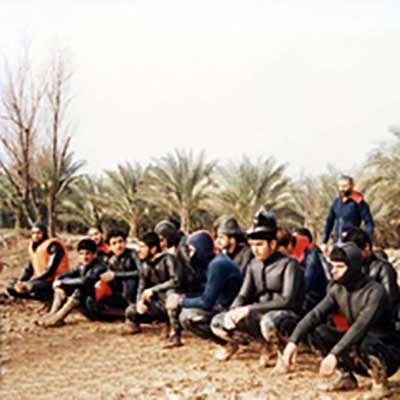Operation Ashura-4
Azamsadat Hosseini
217 بازدید
The 9th Badr Brigade of the Islamic Revolution Guards Corps carried out Operation Ashura-4 in 1985. Its aim was to completely liberate Umm al-Naaj Lake in the operational area of Hur al-Huwayzeh.
In August 1985, the forces of the Badr Brigade liberated a part of Iraq's Umm al-Naaj Lake in the Hur al-Huwayzeh region during Operation Quds-4. Operation Ashura-4 was conducted in an area of 110 square kilometers, and aimed to completely liberate this lake. This operation was carried out with the same formation of forces that operated in the previous operation.[1]
After the Khatam al-Anbiyah Base determined the boundaries of the operational area, they then assigned this operation to the Badr Brigade. They then began the identification and preparation of this area. Furthermore, the information that was given by two defected Iraqi forces, which was very reliable and accurate, played an effective role in this operation.
Iraq had arranged its forces at Umm al-Naaj Lake in two companies. The 6th Battalion of the 117th Brigade was placed at four fixed checkpoints and one floating checkpoint, while the forces named Farsan al-Hur, which means Hur Intelligence Forces, were stationed in Iraq's trenches, prepared to carry out ambushes.[2]
The forces of the 9th Badr Brigade, under the command of Ismail Dagaighi, started Operation Ashuari-4, which was an amphibious operation, with the codename “Ya Musa al-Kazem” at 02:00 on October 21, 1985.[3]
By using the element of surprise and with the effective support of the army's artillery, the forces to the west of the Umm al-Naaj Lake easily reached their goals. In this way, fifteen Iraqi ambush bunkers fell and the advance continued until the lake fell completely. Iraq launched its ambush on the first day of the operation at around 11:00, but the Iraqi mujahid forces of the Badr Brigade, who were ambushed among the reeds, attacked them and neutralized their ambush. The second battle began at 14:00 on the same day with the Baath Army being support by Iraqi PC7 aircraft and artillery. This skirmish ended the same way as the first skirmish and, as a result, the Iraqi forces retreated with a number of dead, wounded and captured, leaving behind eight boats. In this battle, a commander of the Badr Brigade named Abul Khair was martyred.
On November 5, Iraq attacked three times in a row to try and regain the Umm al-Naaj Lake. In the first attack, eight boats were deployed with the support of five PC7 aircraft. In the second, eight boats and one personnel carrier were deployed with air support. The third attack, which came from al-Majri, started with twelve boats and the support of the PC7 aircraft. However, the Badr Brigade fighters camouflaged themselves amongst the reeds and then attacked the enemy. Also, one of the Iraqi Mujahideen of the Badr Brigade, while chasing an Iraqi boat, encountered a technical defect with his gun and could not shoot, so he rammed his boat into the boat of the Iraqi forces, which led to their drowning.[4]
On the first night of this operation, the Badr Brigade created a waterway of nearly eight kilometers. In this way, they were able to prevent infiltration and allow for activity behind the Iraqi command headquarters. In this operation, 76 Iraqi forces were captured and more than 300 were killed during the first moments. On the morning of the operation, despite the firing of several Iraqi tanks, only about fifteen Badr Brigade forces were martyred. This was the result of the tact and intelligence of Ismail Daghaighi, the brigade commander.[5]
Operation Ashura-4 achieved all its set goals and led to the liberation of 110 square kilometers of Iraq's Hur al-Huwayzeh region. Also, 64 bases were destroyed, seven waterways located west of the lake were liberated and three outposts and three Iraqi ambush bunkers were captured.
In this operation, 416 Iraqis were captured, killed, and wounded. A large number of guns and RPGs, 27 boats, 99 pieces of medium weapons, ten pieces of anti-aircraft guns of 14.5-mm caliber, and four pieces of 82- and 60-mm mortars were seized from Iraq. During this operation, 25 checkpoints, one PC7 aircraft, and one hundred Iraqi boats were also destroyed.[6]
[1] Habibi, A., Guide Atlas 4: Azadegan Plain in War, Tehran: IRGC War Studies and Research Center, Vol. 1, 2002, pp. 132 -133.
[2] Drodian, M., Beginning to End: A Journey in the Iran-Iraq War, Tehran: Islamic Revolutionary Guard Corps, Holy Defense Documentation and Research Center, 17th March 2011, p. 140.
[3] Habibi, A., Guide Atlas 4, p. 202; Saeedi, Mostafa, Khursheed Badr, Biography of Sardar Shahid Ismail Daqaighi, Tehran: Propaganda and Publications Department, 1990, p. 67.
[4] Drodian, M., Beginning to End: A Journey in the Iran-Iraq War, pp. 142-145.
[5] Habibi, A., Guide Atlas 4, pp. 132 and 133; Khursheed Badr, biography of Sardar Shahid Ismail Daqaighi, pp. 68-69, 68-69.
[6] Drodian, M., Beginning to End: A Path in the Iran-Iraq War, p. 144; Samii, A., Descriptive record of the operations of Islamic fighters during the eight years of holy defense, Gilan: Vice-Chancellor of Propaganda and Publications of Vali Faqih Representation in the Ground Force, 1997, pp. 208 and 209.



